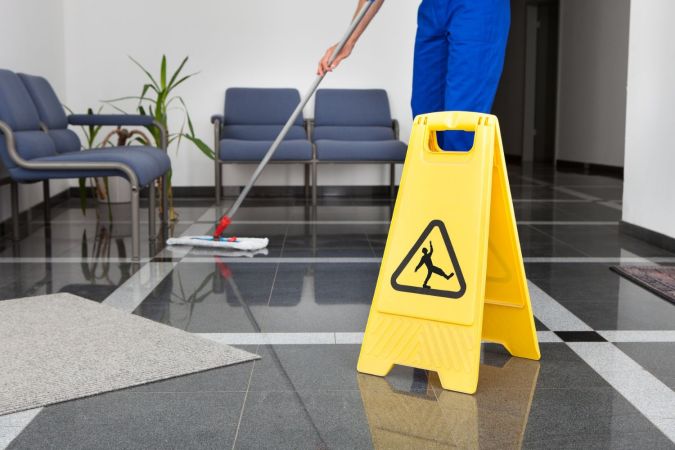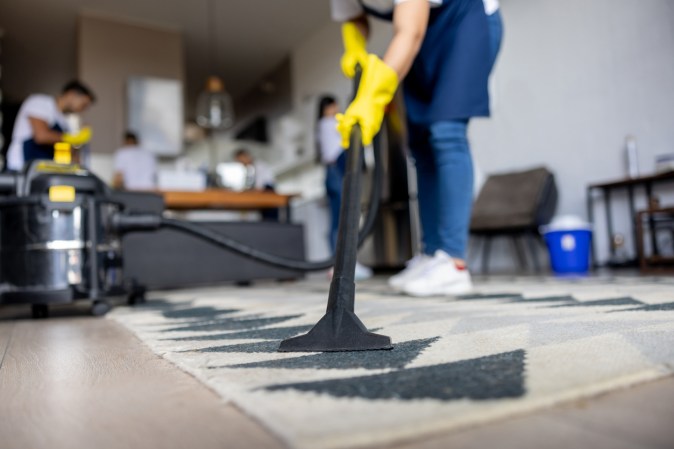We may earn revenue from the products available on this page and participate in affiliate programs. Learn More ›
With their repair expertise and versatile home improvement skill sets, handymen help keep people’s homes in tip-top shape. For those with the right blend of expertise, problem-solving abilities, and a can-do attitude, starting a handyman business can be a lucrative entrepreneurial venture.
Aspiring entrepreneurs will want to learn how to become a handyman not just in name, but in trade and in business. They’ll want to explore the tools of the trade, the importance of certifications, how to navigate the legalities of starting and licensing a handyman business, and the most effective ways to price and market these services.
Before You Begin…
When one thinks of a handyman, the typical image that comes to mind is someone who’s both a jack-of-all-trades and a master of practical problem-solving in the home. A handyman not only fixes what’s broken but also enhances the livability and value of a client’s home. In many cases, a handyman is the first person a homeowner calls for home repairs.
There isn’t a one-size-fits-all blueprint to success for a professional handyman who aspires to become one of the best home repair services. Before embarking on this path, an entrepreneur must navigate regulatory requirements, safety considerations, and varying local ordinances to get their handyman business off the ground. Understanding the importance of liability insurance, the need to stay abreast of building codes, and recognizing the limits of one’s own expertise can make all the difference in whether a budding enterprise thrives or fails. That’s why it’s best for entrepreneurs to take an informed approach to the unique challenges of the handyman profession.
Tips for How to Become a Handyman
- Gain a thorough understanding of local regulations and obtain the necessary licenses and permits before offering services;
- Invest in a comprehensive insurance policy to protect against potential liability and ensure peace of mind for clients;
- Continuously expand home services repair skills through vocational courses, online tutorials, and hands-on experience to stay competitive; and
- Develop a strong network of suppliers, fellow tradespeople, and satisfied customers to support and grow a handyman business.

STEP 1: Take on DIY projects at home to improve your skills and expand on your experience.
Engaging in DIY projects at home can help an aspiring handyman bolster their confidence, widen their technical knowledge, and sharpen their problem-solving skills. Each task undertaken, from straightforward repairs to more intricate renovations, becomes a valuable stepping stone, enhancing the handyman’s practical experience and fluency with various handyman tools and materials.
This direct, hands-on method is crucial; it mirrors the real-life challenges a handyman will encounter, offering a safe environment for innovation and learning through trial and error. Moreover, completing these projects acts as concrete proof of the handyman’s expanding skill set, which can be added to a portfolio to share with potential clients.
STEP 2: Volunteer to help family members or friends with their home repairs or home improvement projects for more experience.
For an amateur handyman, volunteering to assist with the home repair or improvement projects of family members and friends can be an excellent way to gain experience. These projects provide more than just the chance to refine skills; they offer an opportunity to handle a diverse array of tasks in different settings.
Each act of service expands the handyman’s repertoire and understanding of different home layouts and client preferences. It’s in these real-life applications that what’s theoretical can be put to the test, and the hands-on intricacies of the trade are mastered. Furthermore, these projects often lead to word-of-mouth referrals, laying the groundwork for what can blossom into a thriving network of potential clients.
STEP 3: Make a list of current skills to determine which services to offer and identify areas of improvement.
Cataloging existing skills helps to shape a suite of services that the handyman can confidently offer and also highlights the gaps in expertise that need bridging. This inventory acts as both a professional roadmap and a personal curriculum, outlining the strengths to be capitalized on and the weaknesses to be addressed through further training or practice. It enables the handyman to tailor their business to their competencies while also setting clear objectives for enhancing skills.
In the long term, such self-awareness ensures a steady progression in the quality of service offered and fosters a reputation for competence and reliability in the handyman’s growing clientele.

STEP 4: Consider going to a trade school or community college, or taking online courses, to get trained in specialized tasks, such as those related to plumbing, electrical, or HVAC.
Formal education and certification in specialized trades can significantly elevate a handyman’s marketability and service quality. By attending trade school or community college, or even engaging in online courses, an aspiring handyman can acquire targeted training in areas such as plumbing, electrical, or HVAC. This specialized knowledge enables them to tackle a broader spectrum of home repair needs and ensures that the work adheres to the highest professional standards. Obtaining certifications in these specialized trades can also instill greater confidence in clients and can help distinguish a handyman’s services in a competitive market.
In addition, a handyman plumber or handyman electrician can likely take on higher-paying jobs, making their handyman business a much more lucrative one.
STEP 5: Reach out to local handyman service providers to see if they’d be willing to mentor you, or even hire you as an apprentice.
Acquiring experience as a handyman is fundamentally a hands-on process, and one of the most effective ways to achieve this is by learning directly from seasoned professionals. Handymen who reach out to established local home maintenance services may find mentorship opportunities or apprenticeships. Such relationships are invaluable, as they provide real-world experience under the guidance of a skilled craftsman.
As an apprentice, an individual can observe best practices, learn trade secrets, and understand the nuances of managing client relations and business operations. These insights are rarely found in textbooks and can exponentially speed up the learning curve.
Moreover, working alongside a mentor can serve as a critical networking tool for an aspiring handyman, potentially leading to future referrals and collaborations. For the handyman in training, this path not only lays a solid foundation of practical skills but also embeds them within the fabric of the local trade community, establishing early professional credibility for their business.

STEP 6: Seek out entry-level positions with local construction or repair companies to continue building your skills.
Handymen may find that working with local construction or repair companies is a strategic springboard to skill enhancement and professional development. These entry-level roles offer a structured environment where one can continue to learn and practice a variety of tasks, from basic repairs to more complex construction duties, under the support of experienced industry professionals.
“Work in the field for a few years first,” advises Andre Kazimierski, CEO of Improovy Painters Chicago, a Chicago-based on-demand home improvement service platform with locations in Wisconsin, Florida, Illinois, Colorado, and Michigan. “It’s important to gain experience not only with what you’ll be doing, but also with how handyman businesses tend to run, how to communicate with customers, and so on.”
STEP 7: Set prices for your services that are competitive but still allow for profit.
Determining the right pricing structure is a delicate balance for any handyman business. It’s essential for an entrepreneur to conduct market research to understand what most handymen charge per hour, which can vary widely depending on geographic location, level of expertise, and the specific services offered.
The average handyman hourly rate across the U.S. can range from $40 to $140, with some pros charging even more for specialized services. Handymen can also charge per project: The average flat fee for a handyman job is $420, but pricing can go as high as $690 depending on what’s involved. A handyman will want to consider these going rates and then assess their own costs, including materials, travel, and overhead, to set competitive prices that also provide a margin for profit.
With smart financial management and strategic marketing, a handyman business has the potential to be highly profitable. Ideally, prices will reflect the value of the services provided, appeal to the target customer base, and sustain the growth and health of the business. A transparent, competitive pricing model can help generate repeat business and positive word-of-mouth referrals for long-term profitability and success.

STEP 8: Look into local requirements for licenses and permits to make sure you are operating legally within your state.
Every state and certain local jurisdictions have their own specific regulations governing the operation of handyman services. These requirements can encompass a variety of licenses and permits specific to the work being performed, such as general contracting, electrical, plumbing, or HVAC. To obtain a handyman license, an individual typically needs to apply through their state’s licensing board or a similar regulatory body, which often involves passing a trade exam and providing proof of insurance and bonding.
“It’s advisable to research the specific licenses and permits necessary for operating a handyman business in your area,” explains Jimmy Evans, co-owner of San Diego Concrete Construction, a San Diego-based full service contractor for commercial and residential concrete construction. “This might include a general business license, a contractor’s license for certain types of work, or other local permits. Understanding and adhering to all legal requirements will not only prevent potential legal issues but also enhance your credibility and professionalism, instilling confidence in your clients regarding your legitimacy and adherence to industry standards.”
Additionally, being licensed can often allow a handyman to take on larger, higher-paying jobs, as some states limit the dollar value of work that an unlicensed handyman can perform. When a potential customer does an online search for “hiring a handyman near me,” they may be more likely to click on a listing for a licensed contractor.
Once the business is registered and has a state license number, it can be helpful for a handyman to include that number on their website, marketing materials, and handyman business cards to let prospective customers know it’s a legitimate operation.
STEP 9: Get handyman insurance to protect against financial liability from accidents.
Obtaining a policy from one of the best handyman insurance companies (such as NEXT or Thimble) protects both the handyman and their business from possible costly repercussions of an accident. An insurance policy offers protection against a range of potential liabilities, from injuries and accidental property damage to legal fees related to such claims. Aspiring entrepreneurs will want to make sure they budget for handyman insurance costs when making a business plan.
By obtaining the right coverage, which typically includes general liability insurance, workers’ compensation, and possibly commercial vehicle insurance, a handyman can protect their financial interests while ensuring their professional standing. Clients are more likely to hire a handyman who carries insurance, as it offers a measure of protection against accidents or injuries that may occur while a handyman is on the job.
Business owners will want to keep in mind that many states and some corporate clients may require proof of insurance before signing a handyman contract, making it a nonnegotiable aspect of running a legitimate handyman operation.
From sharpening skills with DIY projects to gaining hands-on experience through apprenticeships or entry-level positions, each of these steps is designed to build a solid foundation for offering handyman services. Handyman who understand the importance of legal compliance, setting fair and profitable pricing, and protecting themselves with the right insurance coverage can position themselves to compete with the best handyman services.









